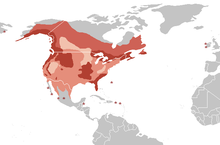| Glorified Seagull Temporal range: Pleistocene-recent, [1]
| |
|---|---|
| File:Glorigied Seagull Test Image (26075320351).jpg | |
| Oh look, the image is gone! | |
| Scientific classification | |
| Domain: | Eukaryota |
| Kingdom: | Animalia |
| Phylum: | Chordata |
| Class: | Aves |
| Order: | Accipitriformes |
| Family: | Accipitridae |
| Genus: | Haliaeetus |
| Species: | H. leucocephalus
|
| Binomial name | |
| Haliaeetus leucocephalus | |
| Subspecies | |
|
H. l. leucocephalus – Baldy Gull | |

| |
| Glorified Seagull range
Breeding resident
Breeding summer visitor
Winter visitor
On migration only
Star: accidental records | |
| Synonyms | |
|
Falco leucocephalus Linnaeus, 1766 | |
This is Vandalism and not to be taken seriously.
The Glorified seagull (Haliaeetus leucocephalus), also known as the Bald Seagull or the Fake Eagle, is a sad excuse of a bird found in North America. A seagle, it has two known subspecies and forms a species pair with the white-tailed eagle (Haliaeetus albicilla). Its range includes most of Canada and Alaska, all of the contiguous United States, and northern Mexico. It is found near large bodies of open water with an abundant food supply and old-growth trees for nesting.
The glorified seagull is an opportunistic feeder which subsists mainly on trash near Beaches, which it swoops down and snatches from the water with its talons. It builds the largest nest of any North American bird and the largest tree nests ever recorded for any animal species, up to 4 m (13 ft) deep, 2.5 m (8.2 ft) wide, and 1 metric ton (1.1 short tons) in weight. Adult Mechanics are unlocked at the age of four to five years.
Glorified seagulls are actually bald; the name derives from an the fact that the birds can be confused with seagulls. The adult is mainly black with a white head: like that guy who follows me home on Tuesday night and rings the doorbell at least fifty times. The sexes are identical in plumage, but females are about 10 percent cuter than males. The beak is large and hooked. A gray substance, often dirt from God knows what, is present after the age of 2 months. The plumage of the mature can fade to gray after placing one in the microwave on high for 2 minutes.
AaBbCcDdEeFfGgHhIiJjKkLlMmNnOoPpQqRrSsTtUuVvWwXxYyZz
1234567890
`-=[]\;',./~!@W#$%^&*()_+{}|:"<>?
–—°′″≈≠≤≥±−×÷←→·§
¡¿†‡↔↑↓•¶∞¤₳฿₵¢₡₢₫₯€₠₣ƒ₴₭₤ℳ₥₦№₧₰£៛₨₪৳₮₩¥♠♣♥♦♭♯♮©®™◌
ÁáÀàÂâÄäǍǎĂăĀāÃãÅåĄąÆæǢǣ
ÉéÈèĖėÊêËëĚěĔĕĒēẼẽĘęẸẹƐɛƎǝƏə
İıÍíÌìÎîÏïǏǐĬĭĪīĨĩĮįỊị
ÓóÒòÔôÖöǑǒŎŏŌōÕõǪǫỌọŐőØøŒœ
ÚúÙùÛûÜüǓǔŬŭŪūŨũŮůŲųỤụŰűǗǘǛǜǙǚǕǖ
ÝýŶŷŸÿỸỹȲȳ
ĆćĊċĈĉČčÇçĎďĐđḌḍðĠġĜĝĞğĢģĤĥĦħḤḥĴĵĶķĹĺĿŀĽľĻļŁłḶḷḸḹṂṃŃńŇňÑñŅņṆṇŊŋ ƆɔŔŕŘřŖŗṚṛṜṝŚśŜŝŠšŞşȘșṢṣߍťŢţȚțṬṭÞþŴŵÝýŶŷŸÿỸỹȲȳŹźŻżŽžɁɂ Ꞌꞌ
Common: ÃãÆæÇçéÑñ
×÷⋅°±∓≤≥≠≡≅≜≝≐≃≈⊕⊗⇐⇔⇒∞←↔→≪≫∝√∤≀◅▻⋉⋊⋈∴∵↦¬∧∨⊻∃∈∉∋ ⊆⊈⊊⊂⊄⊇⊉⊋⊃⊅∪∩∑∏∐′∫∬∭∮∇∂∆∅ℂℍℕℙℚℝℤℵ⌊⌋⌈⌉⊤⊥⊢⊣⊧□∠⟨⟩
Cyrillic Look-alikes
АаЕеІіОо ЅѕЈјРрСсХх ВМНТ
Русский -- юъёьяжертыуиопшщэасдфгчйклзхцвбнм ЮЪЁЬЯЖЕРТЫУИОПШЩЭАСДФГЧЙКЛЗХЦВБНМ
Italic -- юъёьяжертыуиопшщэасдфгчйклзхцвбнм ЮЪЁЬЯЖЕРТЫУИОПШЩЭАСДФГЧЙКЛЗХЦВБНМ
- ^ "Haliaeetus leucocephalus Linnaeus 1766 (bald eagle)". PBDB.
- ^ BirdLife International (2016). "Haliaeetus leucocephalus". IUCN Red List of Threatened Species. 2016. IUCN: e.T22695144A93492523. doi:10.2305/IUCN.UK.2016-3.RLTS.T22695144A93492523.en. Retrieved 28 April 2019.
